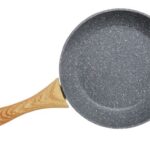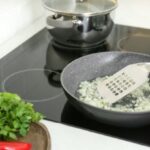What Is Hard Anodized Cookware?
Anodizing is a process in which aluminum cookware is immersed in a chemical bath and treated with an electric current to create an oxide layer on the surface. This aluminum oxide layer has a depth of up to 0.3 mm and makes the cookware resistant to corrosion and deformation. Cookware made from electrochemically hardened aluminum is 8x harder than cookware made from regular aluminum.
Another plus is that the aluminum oxide layer is non-reactive, and it prevents the aluminum base from leaching into food. This makes cooking with hard anodized cookware much safer than with plain aluminum. Regular aluminum cookware can react with acidic food and many people are concerned about the negative effects of aluminum. The adonizing process solved this problem by creating a barrier between the metal and the food.
Although hard anodized cookware is popular among professional and home cooks, this cookware has both advantages and disadvantages.
Hard Anodized Cookware Pros
- Durable: Unlike aluminum, which is soft and prone to dents, hard anodized cookware is resistant to scratches, warping, and other types of damage. Since it is also corrosion-resistant, this cookware will last a long time with proper use and maintenance.
- Excellent Heat Conductor: The best thing about hard anodized cookware is its exceptional thermal conductivity. Aluminum conducts heat incredibly well with no hot spots, which is crucial for dishes that require good temperature control. Be sure to use handle covers or pot holders when handling hot pans.
- Time and energy saver: The hard-anodized aluminum construction ensures fast heat distribution, so not much energy is required to heat the pan. Since hard-anodized cookware isn’t prone to warping it won’t wobble on a range. Instead, it lays flat on the stove and heats quickly and evenly without wasting energy. The hard-anodized aluminum pan needs less heat than one made of stainless steel and cooks faster, allowing you to save time in the kitchen.
- Lightweight: Regular aluminum is a very light metal and aluminum cookware is very easy to handle. Hard anodized cookware is less heavy than most cookware made from other materials and you won’t strain your wrist when lifting it.
- Versatile: Hard anodized cookware is suitable for all types of stoves except induction. Manufacturers sometimes install iron material in the base to make the pan suitable for induction. Hard anodized cookware is a good option for glass cooktops because it has a flat bottom layer that won’t damage the glass. Hard anodized cookware can be used for different cooking methods and the preparation of a wide variety of dishes.
- Reasonable Price: You can buy a set of hard anodized cookware at a reasonable price. This reliable cookware is cheaper than stainless steel or multi-clad cookware.
This post contains links to Amazon. The publisher may get paid if You purchase something through the links without additional costs to You.
Related product: T-Fal Ultimate Hard Anodized Nonstick Fry Pan Set
Hard Anodized Cookware Cons
- Incompatible with Induction cooktops: Because an induction cooker requires cookware made of ferrous materials, hard anodized cookware does not meet this requirement. To make this cookware usable on an induction stove, manufacturers add iron material to the bottom of the pan. Such a pan can be used on an induction stove, making hard anodized cookware even more versatile. The additional ferromagnetic base adds weight, making the cookware less convenient to handle.
- Not suitable for high heat: Low or medium heat is recommended for using this cookware. Do not leave cookware unattended over high heat. The food will not be cooked properly and the result may be burnt dishes. High heat also shortens the life of the additional non-stick layer.
Can hard anodized cookware go in the oven?
Hard anodized cookware can withstand oven temperatures up to 600 degrees F. However, keep in mind that the nonstick layer added to this cookware may reduce its tolerance to high oven temperatures. Read the instructions carefully to find out the maximum oven temperature for your cookware. In addition to the non-stick coating, there are other limiting factors such as lids, plastic or polymer handles, and knobs. Pans with stainless steel handles are oven-safe up to 500 degrees F, while silicone handles can handle heat up to 400 degrees F.
Is hard anodized cookware nonstick?
The anodizing process makes cookware non-stick to a certain extent, but it is still necessary to coat the pan with oil before baking. To create a completely nonstick cooking surface, manufacturers often add an additional nonstick layer. Therefore, modern hard anodized cookware often consists of a thick aluminum base coated with one or more non-stick layers.
Can you use metal utensils on hard anodized cookware?
Although hard anodized cookware is strong and durable, regardless of the advertising, you should avoid using metal utensils. Metal utensils such as spatulas and mixing spoons can damage the protective oxidation layer. If the dishes have an additional non-stick coating, using a sharp metal spatula is also not recommended. Wooden, bamboo, nylon, and silicone cooking utensils are a much better choice.
Can hard anodized cookware go in the dishwasher?
The instruction manual often states that hard anodized cookware is dishwasher safe. However, most cookware has one or more additional non-stick layers. Any nonstick cookware will last longer if washed by hand. Detergents and heat in the dishwasher can affect nonstick functionality and hard anodized nonstick cookware is no exception.
How to clean hard anodized cookware?
Certain brands of hard anodized cookware are dishwasher-safe. However, you must read the instruction manual to make sure this applies to the cookware you purchase. By only hand washing the cookware, you can be sure that it will stay in good condition for a long time. This cookware is also easy to wash by hand.
Before first use, the cookware should be washed with warm water and liquid dishwashing detergent. Rinse with warm water and dry immediately to avoid water stains. When stacking pots and pans, place paper towels on the bottom of each item to prevent scratches.
For regular cleaning after use, wash the cookware in warm, soapy water using a soft sponge or nylon scouring pad. Allow the cookware to cool to room temperature before cleaning, but do not leave it unwashed for a long time, otherwise, food residue may harden.
To remove burnt food particles, cook a 50/50 mixture of white vinegar and water in the pan.
Avoid harsh cleaners, steel scouring pads, and other abrasives as these can damage the protective coating. This precaution also applies to cookware with additional non-stick coating.
To remove burnt marks on the exterior, use Bar Keeper’s Friend Cleanser and a non-abrasive sponge.
With proper care, investing in hard anodized cookware is worth it in the long run.
How long does hard anodized cookware last?
Cookware made from hard anodized aluminum is known for its durability. Cookware with an additional non-stick coating does not last long because the functionality of the non-stick coating tends to decrease over time and use. What this practically means is that after a few years of regular use, you may want to replace your old nonstick cookware with a new set.



